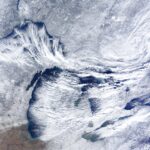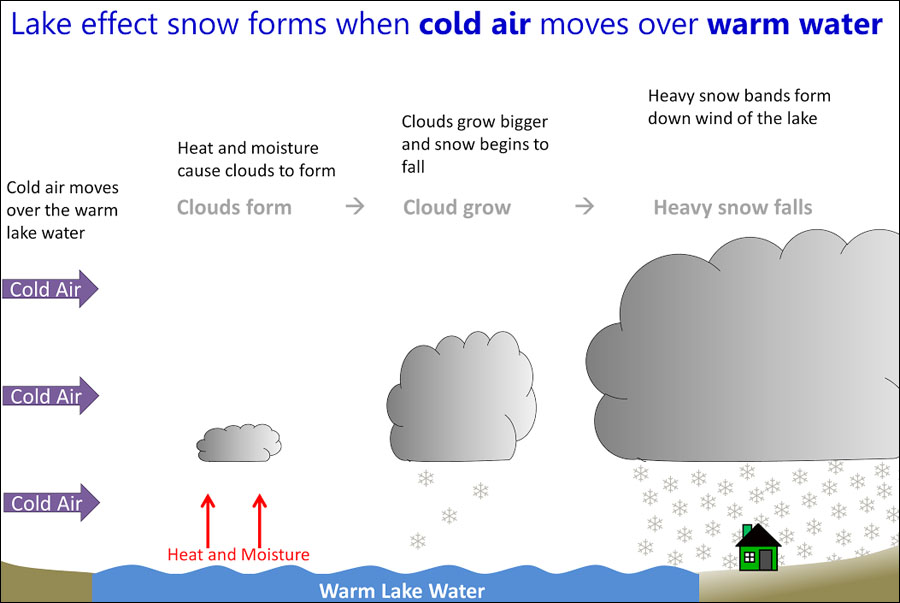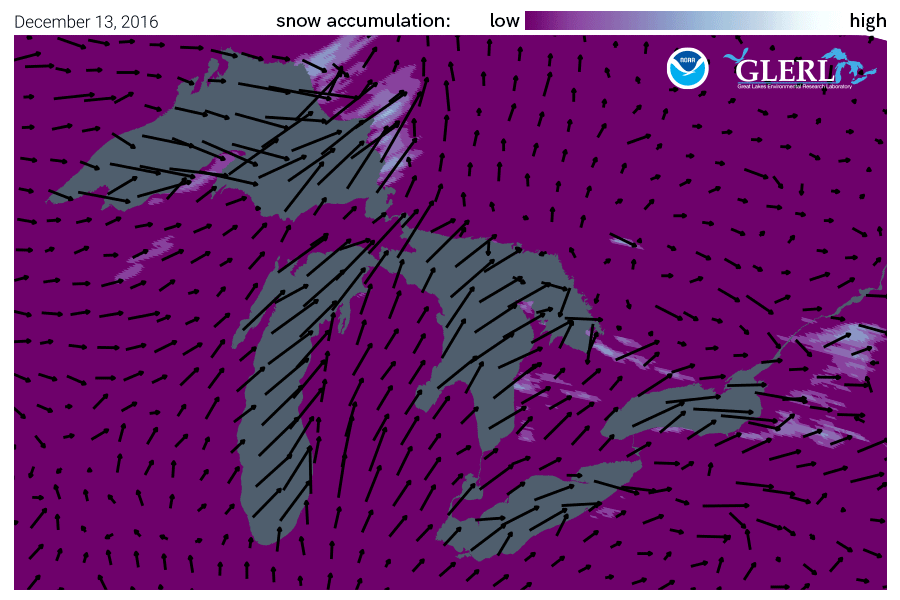Each spring, NOAA’s Great Lakes Environmental Research Laboratory (GLERL) conducts an analysis of how Great Lakes ice conditions progressed throughout the previous winter. This analysis, which compares the past winter’s conditions to historical trends, helps us understand the key factors that influence ice formation, how ice conditions have changed over time, and how we might predict future ice cover. Ice cover data is highly valued because it plays a critical role in both the ecology and economy of the Great Lakes region. Lake ice affects everything from snowfall and fishery populations to recreational activities and the multibillion-dollar commercial shipping industry.
The 2024-2025 winter Great Lakes ice season stayed close to long term normals following the near historic low ice levels seen in the 2023-2024 winter (Figure 1). One way that GLERL tracks ice cover is by looking at the daily percentage of ice cover across the Great Lakes, calculated by determining the area of the Great Lakes that are covered by ice and dividing that by the total surface area of the lakes. The daily percentage of ice covering each of the Great Lakes this winter is shown in the figure below.
However, despite colder temperatures than last winter, most of the lakes stayed slightly below long term averages on a daily basis through the season. Figure 2 shows 2025 daily ice cover percentages compared to 2024 ice cover values and other past seasons. Note that the 2025 ice season had an increase in ice cover compared to last year, but it did not approach record levels.
Each of the Great Lakes responds differently to seasonal changes due to unique physical characteristics—particularly their size and depth. Deeper lakes, for example, retain heat longer and may experience delayed or reduced ice cover compared to shallower ones. Similarly, larger surface areas can influence how wind and air temperature affect ice formation. Figure 3 illustrates the differences between lakes by showing the size and depth of each lake.
Let’s compare ice cover between Lake Michigan and Lake Erie. Lake Michigan, with its relatively deep basin, tends to warm and cool more slowly than shallower Erie. As a result, Lake Michigan experiences a more gradual formation of ice and typically has lower overall ice cover. In contrast, Lake Erie, the shallowest of the Great Lakes, loses heat more quickly and develops ice cover earlier in the season. As a result, Lake Erie quickly covers with ice when air temperatures stay below freezing.
This winter season began with warm water temperatures across the Great Lakes, with little-to-no ice coverage in December. However, temperatures dropped in January and Lake Erie saw above normal ice from late January to early March (Figure 4). Lake Erie, the smallest and shallowest lake, lost heat relatively quickly while the larger lakes didn’t reach the temperatures needed for ice generation until later in the season, or only over smaller portions of the lake.
Why did Ice Percentages Peak in Late February?
The first three weeks of February were cold, with below average air temperatures allowing ice to build. A shift occurred during the 4th week of February when above normal air temperatures were recorded across the Great Lakes, reversing ice growth. Figure 5 shows the air temperatures since January 1st, 2025 for select cities across the Great Lakes. The shift from cold, below normal temperatures to warm, above normal temperatures during the 4th week of February is evident at each location, regardless of geography.

Seasonal Averages: A look at the numbers
The 2024-25 annual maximum ice cover is compared to the long term average in the table below, showing that overall, maximum ice cover was close to average this season.

The average ice coverage between January and March is shown in the table below in comparison to the full season annual max ice cover above. Ice cover was typically below average.

The number of days with ice coverage greater than 10% is shown. The majority of lakes and the basin-wide total both indicate that this winter was slightly below long term averages.

The tables below show how this past winter ranked with respect to records from the previous 51 years. Much of the data indicates that ice cover in general was slightly below average.
| Basin-Wide | Superior | Michigan | Huron | Erie | Ontario |
| 28th | 36th | 26th | 21st | 10th | 23rd |
| Basin-Wide | Superior | Michigan | Huron | Erie | Ontario |
| 38th | 38th | 37th | 38th | 29th | 24th |
| Basin-Wide | Superior | Michigan | Huron | Erie | Ontario |
| 36th | 39th | 36th | 36th | 25th | 28th |
What was happening globally that played a role in determining ice cover in the Great Lakes?
During the winter, ice cover on the Great Lakes is influenced by four large-scale climate patterns from the Atlantic and Pacific: the North Atlantic Oscillation (NAO), the Atlantic Multidecadal Oscillation (AMO), the El Niño-Southern Oscillation (ENSO), and the Pacific Decadal Oscillation (PDO). These patterns describe conditions that can lead to above average or below average temperatures in the Great Lakes, depending on their position. In February, both the AMO and PDO drove strong and steady warming during the entire ice season – except for the month of February. February was marked by below-average air temperatures, including a 16-day streak of colder than normal weather in the middle of the month. While the NAO stayed near normal, while ENSO was in a cooling phase. On February 22, the ENSO-induced cooling caused ice cover to briefly peak at 52% but conditions quickly warmed, which correlates with the status of global climate patterns at that time (the 3rd warmest February). The strong warming effects from AMO and PDO meant the brief increase in ice cover linked to ENSO didn’t last long. GLERL predicted at mid-December and mid-January a similar but slightly higher range of maximum ice cover (between 53–66%) than occurred. These predictions are provided each year by a statistical ice coverage model based on the four climate patterns.



























